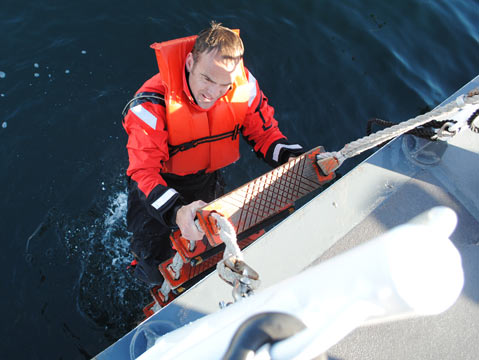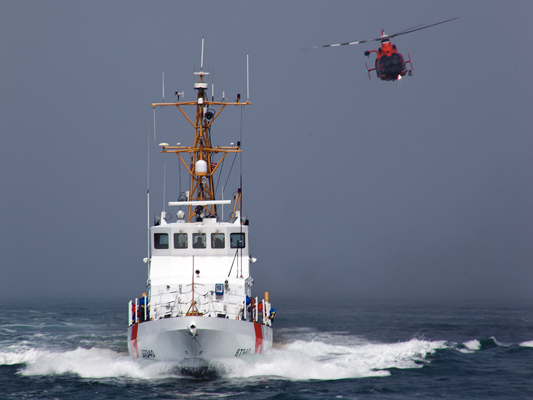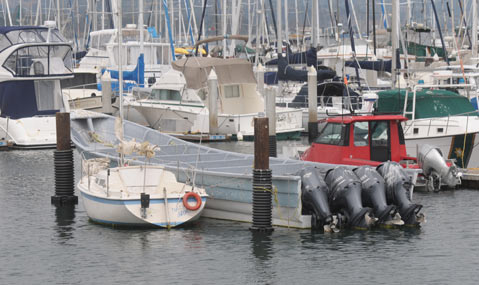SPECIAL REPORT: Details Revealed in Coast Guard Officer’s Death
Also How, When, and Why Pangas Are Pushing into Santa Barbara Waters

Since 2008, United States law enforcement has tracked 667 incidents of maritime smuggling along California’s coastline, a dramatic uptick from years prior due to successful crackdowns on the land border. Most of the ocean encounters involved panga boats, small, fast, stripped-down vessels often laden with marijuana and migrants that Mexican smugglers zip from south-of-the-border ports to Southern California shores.
While 3,007 arrests have been made and more than 121 tons of drugs seized over the last four years, this Sunday marked the first time that a law enforcement agent was killed responding to suspicious panga activity in U.S. waters, a sign that the sea-bound smugglers are becoming more audacious and violent in their tactics.
Chief Petty Officer Terrell Horne III, a veteran of the U.S. Coast Guard and second in command on the patrol cutter Halibut, suffered a fatal head injury when a 30-foot panga lurking in the middle of the night near Santa Cruz Island rammed his boat. From Redondo Beach, Horne was 34 years old and leaves behind a pregnant wife and small child. He was remembered by his fellow sailors as a “friend, a “confidant,” and “the glue that held our crew together.”
Two men operating the panga were arrested and charged with Horne’s death. They await trial in Los Angeles. The investigation into the incident is ongoing, and Santa Cruz Island has been shut down and evacuated of visitors and National Park Service workers as authorities comb the 97-square-mile area for evidence. Tuesday morning, several bales of marijuana were found floating near the scene, but officials didn’t say if the discovery is linked to the case. Coast Guard and National Park Service media representatives couldn’t confirm or deny reports that two suspects remain at-large on the island.
Though details surrounding the collision were initially vague, a clearer picture of what took place emerged from the criminal complaint filed Monday afternoon in L.A. District Court. Drafted by a Homeland Security special agent, the affidavit is based on interviews with 16 Coast Guard officers, a Border Patrol agent, and the two defendants.

Shots Fired in Smuggler’s Cove
At around 11:30 p.m. Saturday night, the complaint reads, a Coast Guard C-130 airplane on routine patrol out of Sacramento spotted a recreational boat one mile from Smuggler’s Cove at Santa Cruz Island. It wasn’t moving and had all navigational lights turned off. The aircraft crew radioed the Marina del Rey–based Halibut, which was patrolling nearby.
The Halibut located the boat, boarded it, and arrested two people suspected of smuggling drugs. Though the complaint doesn’t say if any narcotics were found and provides no other information on the arrest, including the suspects’ identities, it states the Coast Guard officers found a number of extra gas barrels on board. “Based on my training and experience,” wrote special agent Joel Widell, “I believe the recreational vessel may have been serving as a source of fuel supply for an illegal narcotics or illegal alien smuggling operation.”
Shortly thereafter, the affidavit goes on, the C-130 radioed the Halibut that it had located a panga in Smuggler’s Cove. In response, the cutter launched its intercept boat — a 21-foot rigid-hull inflatable — with four crewmembers on board, including Horne. After some searching, they located the panga at approximately 1:20 a.m. They crept to within 20 yards of it before turning on their boat’s flashing lights and ordering — in English and in Spanish — those aboard to put their hands in the air.
The panga immediately throttled its engines and veered toward the Coast Guard boat, the complaint reads. The Coast Guard crewmember at the wheel tried to steer out of the way, and another officer fired his service weapon at the panga, but it slammed into the front left side of their boat, throwing Horne and another sailor into the water. The panga then sped away.
The two officers were quickly pulled from the ocean. Horne, it was discovered, had been struck in the head by a propeller. The crew administered first aid and rushed back to the Halibut, which sped to Port Hueneme in Ventura County, but Horne was pronounced dead on arrival. The other crewmember suffered a cut to his knee.
After three failed attempts to outrun the Coast Guard boat, the panga was eventually stopped at gunpoint after officers pepper-sprayed the two occupants.
During all this, the C-130 continued to track the panga as it headed south. The plane was eventually joined by a Coast Guard helicopter and a response boat, which intercepted the panga at around 5:05 a.m., 20 miles north of the United States/Mexico border. After three failed attempts to outrun the Coast Guard boat, the panga was eventually stopped at gunpoint after officers pepper-sprayed the two occupants. The driver resisted arrest, the complaint reads, and the passenger was detained without incident.
The two men have been identified as Jose “Blacky” Meija-Leyva and Manuel Beltran-Higuera. On board their seized boat — which was riddled with bullet holes, including one in front of the steering column — was a satellite phone, cell phone, handheld GPS, and a knife.
Meija-Leyva, the panga’s captain, initially waived his Miranda rights when speaking with investigators, the affidavit states. He told authorities he was taking gas to friends lost north of Los Angeles. After giving that statement, however, he asked for an attorney, and the questioning stopped.
Beltran-Higuera told officials he was a Mexican citizen and that, while in Ensenada, Baja California, he had been approached by a man offering to pay him $3,000 to bring a load of fuel to an awaiting panga boat in the U.S. He agreed and made the trip north with Meija-Leyva, but when they arrived at the prearanged location, the second panga wasn’t there, he told investigators. After about 20 minutes of waiting, they were spotted by the Coast Guard.
Little else is publicly known about the two men, including their ages, hometowns, or criminal histories. Calls to the media departments for Homeland Security and Immigration and Customs Enforcement (ICE) were not returned, and the names of their defense attorneys were not immediately available. The men’s first pretrial court appearance was this Tuesday in Los Angeles.

In Defense of the Coast
More and more often, Mexican smugglers are using nondescript recreational boats to make landfall with their cargo, rather than run now-notorious pangas directly to shore. That was one of the main takeaways from a large gathering of federal, state, and local law enforcement agencies at the Santa Barbara Harbor this July. Attended by Congressmember Lois Capps, Sheriff Bill Brown, 3rd District Supervisor Doreen Farr, and members of the SBPD and CHP, the meeting was called in direct response to increasing pangas in Santa Barbara waters.
Just a month earlier, six men were arrested near El Capitán State Beach for trying to sneak 1,400 pounds of marijuana — worth an estimated $4.2 million — to shore. In July 2010, 15 Mexican nationals were rescued from Santa Cruz Island after being abandoned without food or shelter. More recently, three men were arrested this November north of San Miguel Island in a panga boat packed with 35 large bundles of weed.
The smuggler’s location of choice has historically been any remote stretch of sand close to main roads and highways — watched over by an on-land spotter — for quick transfers to waiting trucks and trailers.
There have also been multiple sightings and recoveries of abandoned pangas up at Refugio Beach, down near Fernald Point in Montecito, and at various points in between. The smuggler’s location of choice has historically been any remote stretch of sand close to main roads and highways — watched over by an on-land spotter — for quick transfers to waiting trucks and trailers. But with the rising use of recreational boats, authorities are concerned they could sneak straight into populated harbors.
Brown said there have been 21 panga-related incidents in Santa Barbara this year alone. Eight involved illegal immigrants; four involved narcotics. Most of those encounters had not been made public. Increasingly, Sheriff’s Department spokesperson Sergeant Mark Williams said, state and federal authorities are taking the lead on cases and interdictions are now being handled almost exclusively by a combination of personnel from Homeland Security, ICE, Customs and Border Protection, the Coast Guard, the National Guard, and the State and National Park Services. Most arrestees are transferred to the custody of ICE.
Though media weren’t allowed into this summer’s powwow and invitations went to top brass only — Santa Barbara Harbor officials were notably absent — Capps told reporters afterward that it was a constructive exchange of ideas and strategies that will help keep her constituents safe. She and Brown said it was their goal to better tap into federal resources already enjoyed by jurisdictions farther south — San Diego, Orange, and Los Angeles counties — whose successful enforcement efforts are nudging pangas up the coast.
This Wednesday, the S.B. Sheriff’s Department was notified it will receive $50,000 in grant money as part of Operation Stonegarden, a $50-million federal initiative to reinforce border defense. Our state as a whole received $12 million to be distributed county to county by the California Emergency Management Agency. San Diego and Los Angeles counties have been given the majority of the money doled out so far.
The $50,000, Brown said, will help offset overtime costs incurred during future anti-panga missions. Capps media rep Ashley Schapitl said the congressmember is actively working to ensure local law enforcement gets its fair share from available pots of money, including the State Homeland Security Grant program budgeted at $294 million for the 2012 fiscal year.
Of all the recent panga arrest cases in Santa Barbara County — the Sheriff’s Department was unable to provide a total number — only one has been prosecuted, according to Deputy District Attorney Mary Barron. Two of the six men arrested during June’s El Capitán bust were sentenced this week: Mauricio Brito, convicted of conspiracy to commit the sale or transportation of marijuana, received 308 days in County Jail. Dieber Chavez received 180 days in jail on the same charge. Marco Rangel and Habel Herrera had been sentenced to 252 days and 308 days, respectively, but are on immigration holds. The other two men are awaiting their sentencing dates.



